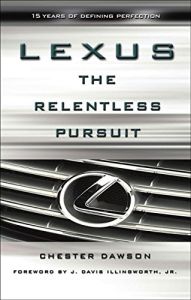Join getAbstract to access the summary!

Join getAbstract to access the summary!
Chester Dawson
Lexus - The Relentless Pursuit
How Toyota Motors Went From "0-60" in the Global Luxury Car Market
Wiley, 2004
What's inside?
Toyota set out to create automotive perfection using innovative design and engineering. The result? Hello, Lexus.
Recommendation
This is a great manufacturing love story in which Toyota, an automaker clearly in love with its product, decides to go after the U.S. luxury car buyer, a suitor who has repeatedly ignored its advances. To get America’s attention, Toyota must first re-invent itself. It must make itself more handsome (through better styling), improve its physique (be faster, stronger and need less maintenance) and prove its financial management skill (by selling great cars for less). Because time is fleeting and the buyer has many other suitors (Mercedes Benz, Jaguar, Nissan, Volvo), Toyota must work fast before its intended lover makes an irrevocable decision and buys someone else’s car. Like some other love stories, this is repetitive and suffers from some plain old sloppy editing. But it makes you want to test-drive a Lexus to see what causes such a sensation. getAbstract recommends this book to CEOs and sales and marketing executives who dream of producing revolutionary, successful products for the global marketplace. And who would mind getting a little consumer love?
Summary
About the Author
Chester Dawson is an editor at BusinessWeek and has been a frequent contributor to auto industry coverage since he joined the magazine in 2000. He spent 10 years in Tokyo covering Japanese corporations for BusinessWeek, The Far East Economic Review and Bloomberg News. He is a graduate of Harvard University and Ohio University.

















Comment on this summary